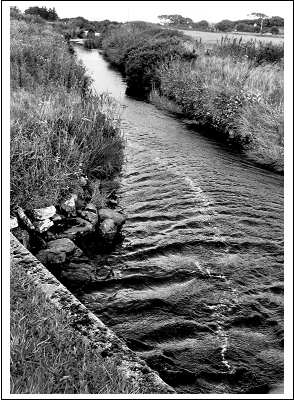| Telfords Mill Lade at Wick (by
Jenny Bruce) Background
In June 2005, working from the transcripted letters of Thomas Telford, a
small group comprising Fred McBoyle (ex- water engineer), Garry Robertson
(local historian), David Scott (film maker) and Jenifer Bruce (local
artist) walked and filmed Telford’s water course from Hempriggs Loch into
Wick, noting the state of it. Following this investigation and further
archive work, plans were set in motion to organise a heritage walk. So in
September 2006 as part of Scottish Archaeology Month and as a Caithness
Arts Festival event, the walk and exhibition was organised to explore
Telford’s water scheme or “mill lade”. 16 people participated, walking
part of the negotiable paths to Barns of Hempriggs where Mr Dane Budge
gave his account of his family’s connections and use of the mill. After
lunch the group proceeded by car to view newer developments at the
Distillery and the District Heating
Scheme, finishing at McKay’s Hotel where a Telford Tea was
supplied and the archive exhibition was displayed.
Telford’s Mill Lade
Thomas Telford, Scottish architect, civil engineer and road, bridge and
canal builder of the 18th and 19th centuries, is renowned for his
remarkable achievements throughout Britain. However the town of Wick is
indebted for is technical genius in planning not only roads in the county
but also but also the harbour, town and water scheme of Wick 200 years
ago.
 Through
the influence of his wealthy patron, Sir William Pultney and the British
Fisheries Society, Telford, in his report of 1790 recommended that Wick
was the most suitable place on the North-East coast for development as a
fisheries station. In order to ensure economic stability a settlement was
needed for the workers and work space for the trades. Hence the concept of
building the settlement of Pultneytown on the south side of the Wick river
and the need for a plentiful water supply. Through
the influence of his wealthy patron, Sir William Pultney and the British
Fisheries Society, Telford, in his report of 1790 recommended that Wick
was the most suitable place on the North-East coast for development as a
fisheries station. In order to ensure economic stability a settlement was
needed for the workers and work space for the trades. Hence the concept of
building the settlement of Pultneytown on the south side of the Wick river
and the need for a plentiful water supply.
Although Telford had taken the levels of Loch Hempriggs
in 1804 and seen that the water could be transported with ease, it was not
until March 1807 that the feu contract was completed between the British
Fisheries Society and the landowner, Sir Benjamin Dunbar. One condition of
the contract was that the new watercourse should also supply the corn and
barley mills of the Dunbar estate. In July 1807 development started on the
construction of the harbour, town, main bridge and the watercourse.
The lade channel is constructed exactly as stated in
Telford’s original letters using Caithness slate laid in horizontal dyking
and is still in use today. Drainage from adjacent fields does not pollute
the course as all surplus water runs into underground culverts below the
level of the channel – another of Telford’s ingenious concepts.
The rise on the surrounding ground also creates an
optical illusion, as the water appears to run uphill at one point. The
mill lade, as it is known locally, fed the subsequent corn and barley
mills, the mill pond, the brewery and the distillery before flowing via an
underground culvert to emerge at the Harbour Bank and possibly a fountain
where the fishermen could draw fresh supplies of the salubrious water of
Hempriggs. You can still see evidence of where the water drains into the
harbour at this point.
It was not until 1845 that piped water was fully
available in the settlement and the Albert Reservoir was in operation.
Later, in 1906 Loch yarrows was connected to Loch Hempriggs to cater for
the increasing population of Wick and a new piping system installed.
The lade, until recently, was used in the washing and
cooling processes of Pultneytown Distillery, but with new filter tanks
installed the lade water is being used directly for the production of
whisky.
In 2006, in order to accommodate the new wood-burning District Heating
Scheme, a diversion of the channel meant that a new culvert had to be
constructed to ensure a regular flow. |
 Through
the influence of his wealthy patron, Sir William Pultney and the British
Fisheries Society, Telford, in his report of 1790 recommended that Wick
was the most suitable place on the North-East coast for development as a
fisheries station. In order to ensure economic stability a settlement was
needed for the workers and work space for the trades. Hence the concept of
building the settlement of Pultneytown on the south side of the Wick river
and the need for a plentiful water supply.
Through
the influence of his wealthy patron, Sir William Pultney and the British
Fisheries Society, Telford, in his report of 1790 recommended that Wick
was the most suitable place on the North-East coast for development as a
fisheries station. In order to ensure economic stability a settlement was
needed for the workers and work space for the trades. Hence the concept of
building the settlement of Pultneytown on the south side of the Wick river
and the need for a plentiful water supply.